TechRadar Verdict
If you're shopping for a compact car with sharp looks, useful driver assist technologies and an intuitive infotainment system, the Elantra is worth a look.
Pros
- +
Android Auto and Apple CarPlay support
- +
Driver assist technologies
- +
Blue Link telematics
- +
Sharp looks
Cons
- -
Unnecessary hands-free trunk
- -
Adaptive cruise can't stop the car
Why you can trust TechRadar
Compact cars were once the vehicles you were forced to buy because you were tight on cash, so they were fairly stripped down, at least in the United States. The last decade has been good to the compact car market, though.
The mid-aughts saw more compact cars available with higher-end options, like leather interiors, heated seats and navigation systems. And now, new compact models from the last two years gained driver assist technologies, too.
Hyundai announced the new 2017 Elantra at the 2015 Los Angeles Auto Show, to replace the previous model that's been around since the 2011 model year. The last-generation Elantra was when Hyundai got the styling right, with its fluidic sculpture design language.
Before the 2011 Elantra, Hyundai's second oldest model name was never something I would consider "good looking". Now on its sixth generation, the Elantra sports sharp new looks in a variety of vibrant colors.
I flew out to Imperial Beach, Calif. to drive the new Elantra along the area's windy roads to get a feel for the car. Hyundai only had Elantra Limiteds with the tech and ultimate packages available, for a total MSRP of $27,585 (not available in the UK or AU yet), for the main drive route. A prototype Elantra Eco was available to drive on a shorter route afterwards.
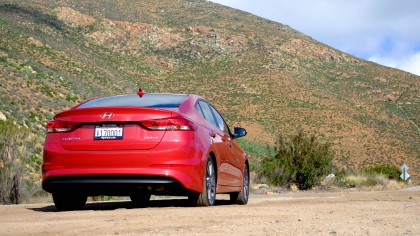
Styling-wise, the 2017 Elantra loses the aggressive creases and swoops from the last generation for a smoother and refined look, but I dig it. The best view of the new Elantra is definitely from behind, with stylish LED tail-lights and trunk-lid that mimics a ducktail spoiler.
Speaking of the backside, the Elantra Limited has a hands-free smart trunk, like the Kia Optima. The Elantra's implementation of the hands-free trunk is just as flawed, unfortunately. It can automatically release the trunk, but isn't powered or able to launch itself open automatically, so you still have to reach and lift the trunk open.
The front end sports Hyundai's trademark hexagonal grille with LED lights and high-intensity discharge (HID) projector beam headlights. The door handles are chrome – which I despise, because it's a fingerprint magnet – but the rest of the car is light on the chrome. I'd prefer the car to have painted door handles and black-out trim, but that may have to wait for the upcoming Elantra Sport that's coming later this year.
Interior
Reach for the door handle, and manually press the lock and unlock button to get into the car. The Elantra Limited features push-button start and passive keyless entry, but there isn't a sensor in the door handle that automatically unlocks the car when you reach for it.
Step inside, and you'll find an interior layout that resembles the larger Sonata midsize sedan, which isn't a bad thing. The layout is straightforward, with an LCD mounted high and center.
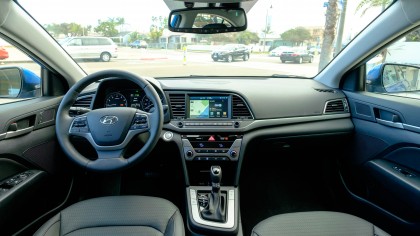
Hyundai sticks to buttons and knobs for the infotainment system and climate control, which I greatly appreciate. The Elantra makes liberal use of silver trim to break apart the black interior, instead of just glossy black, fortunately.
The top half of the dash is covered in soft-touch materials, but everything below the silver dividing trim is covered in cheap, hard plastic. While I'd prefer more soft touch materials all around, this is typical of the compact segment. The door and center armrests are covered in soft material, but there's very little padding underneath, but my elbows weren't in pain after a long day of driving, either.
Hyundai did a great job making the Elantra seats comfortable, at least on the Limited trim. There's plenty of side bolster support on the upper and lower cushions to keep you in place during aggressive driving. The lumbar support is adjustable, too.
The seat foam is made of soybeans, which is better for the environment than petroleum-based foams that were previously used. I asked Hyundai if the soy foam was edible, but a representative advised against it and gave me funny looks when I attempted to lick the exposed demo on display.
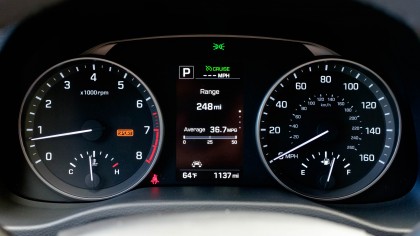
Hyundai sticks with analog gauges for the tachometer, coolant temperature, speedometer and gas. The tech package adds a 4.2-inch LCD in between the speedometer and tachometer. The LCD serves as a fancey trip computer that also shows turn-by-turn navigation directions, driver assists and lets you adjust vehicle settings. The arrangement works well, and I have zero complaints.
Infotainment system
A 7-inch LCD is standard on Limited trim levels, but the car I tested had the tech package that bumps the screen size to 8-inches and adds native navigation features. The infotainment system is virtually the same one as the Hyundai Tucson, which also bears resemblance to the Kia Optima.
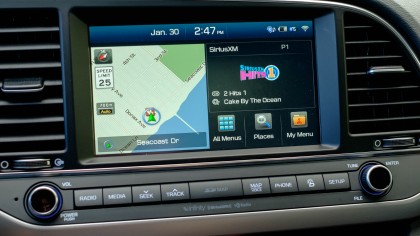
Features are the same too, with HD Radio, SiriusXM, Travel Link and USB connectivity. SiriusXM supports time-shifting for stations set to the first six presets. There were no surprises with the Elantra Limited's infotainment system – it's easy to use with an intuitive interface.
There's a home screen that shows a miniature navigation map with the speed limit, music information and a couple shortcuts, which is all the information I need most of the time. The navigation maps are plain, flat maps that are typical for mainstream cars.
Android Auto and Apple CarPlay
Despite having the same Hyundai Display Audio infotainment system as the Tucson, the Elantra has Android Auto and Apple CarPlay working. I briefly tested Android Auto with my Google Nexus 6 by plugging it in with a micro USB cable. The phone detected Android Auto compatibility, launched the companion app on the phone and asked me to accept the connection.
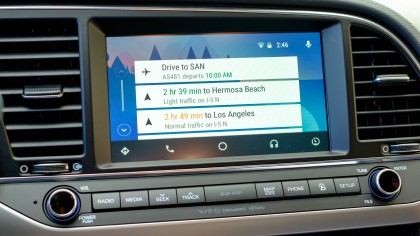
The beauty of Android Auto is it automatically pairs the phone to the car via Bluetooth for hands-free calling. After it connected, the Google Now interface shows up on the car's 8-inch screen. Hyundai's native infotainment interface is still available to use for navigation and music, so you can use whichever one you like better. I rely a lot on Google services, so i stick to the Android Auto interface most of the time, because Google is a life-time commitment whereas the Elantra is a brief affair.
I spent most of my drive using Apple CarPlay, simply because I'm using a trial Apple Music subscription, so I had all my music on my iPhone 6S. CarPlay works similar to Android Auto and automatically asks to connect to the car when you plug-in the phone to the USB port. It also automatically pairs the phone via Bluetooth for hands-free communications, but music audio is sent over Lightning.
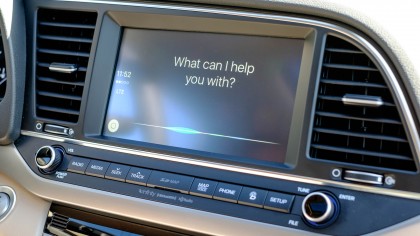
Everything works as it should, with the phone projecting a familiar iOS interface on the 8-inch screen. The Hyundai button takes you out of the CarPlay interface back to the Hyundai home screen. If you're using CarPlay for music, the music information passes onto the Hyundai's home screen, too.
When you're using CarPlay, the voice recognition button on the steering wheel automatically triggers Siri with a single press. Hyundai's method doesn't require holding the button down, like with some Siri Eyes-Free implementations.
Ultimately, Android Auto and Apple CarPlay work great in the Hyundai Elantra, so you shouldn't have any problems regardless of whether you're using Android or iOS.
Current page: Design, interior and infotainment
Next Page Infinity sound, Blue Link and driver assists